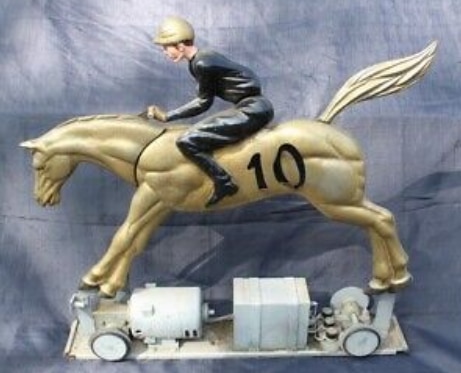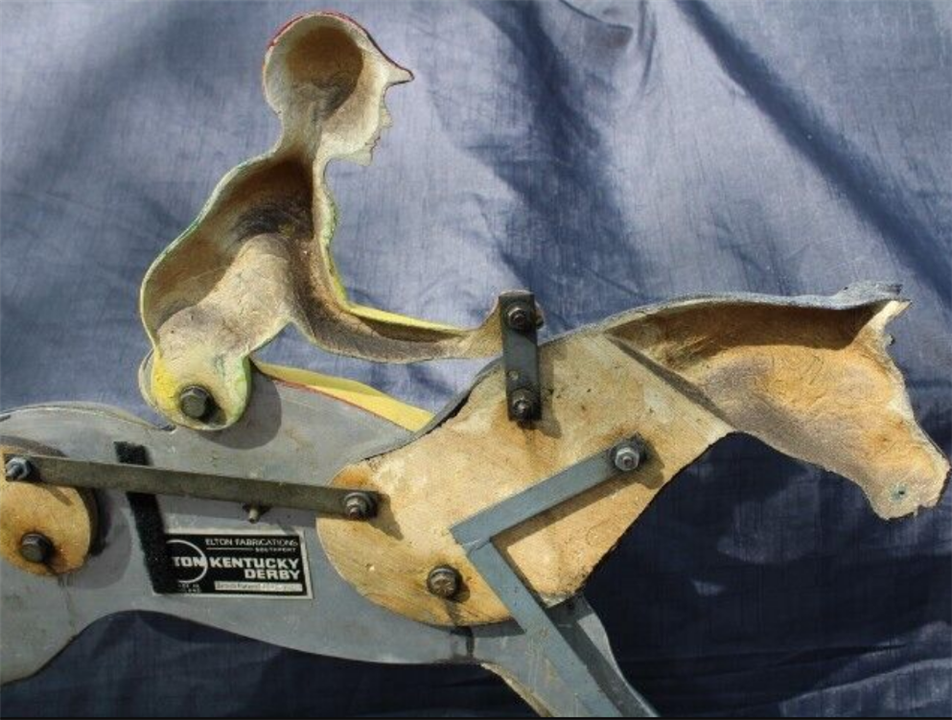I included the episode for context. Can someone please recreate this project for horse racing like the carnival arcades instead of the STAVA Lorraine created? I would truly enjoy making this now that I am retired. Thanks
Mike
I included the episode for context. Can someone please recreate this project for horse racing like the carnival arcades instead of the STAVA Lorraine created? I would truly enjoy making this now that I am retired. Thanks
Mike
You may need to start by sharing some pictures of the version of the game that you are after creating, as they vary quite a bit.
Over here in my youth it was known as the 'Donkey Derby' but that I believe that was a copy of George Valentine Tonner's 'Kentucky Derby' game. Some had animatronic horses on a Scalextric type track whereas some were pulled along by ropes wrapped around pulleys more like Lorrainbow's design. Some were controlled by rolling balls into pockets, and others by tapping switches alternately. Horses have been replaced by camels and rabbits as well.
I recall that some were based on linear tracks like Lorrainbow's Strava version whereas some were based on oval tracks.
Size varied a lot as well from the large arcade versions like this Blackpool Pier Entertainment - Donkey Derby to small table top toys like this Desktop Horse Racing Derby .
The ball-rolling ones tended to be at the larger end of to scale so not clear as to how large a build your were thinking of ?
I'm going to reply to both. I'll have to read up on the break beams. Only one ball would be in play.
Maybe having chutes at the low end with beam sensors would work best. 3 on one chute, 1 on one, and 2 on a third.
The ball has to roll past them to go in the hole. Roll the ball down with dowels for it to bump against, then the ball returns underneath.
I think I'll use the eight digit counters for scoring but I'll definitely check the video out, if just to learn from. Thanks my friend.
I'll have to read up on the break beams.
Diffused, through-beam and retroreflective sensors - what's the difference?
Roll the ball down with dowels for it to bump against
This is where you can add your own twist to the game play by borrowing features from other ball based games as well as introducing your own. If you stick a sensor on the dowel then it can trigger a sound effect or a light animation or affect the scoring anytime it gets bumped.
You may need to consider chance vs skill to keep people entertained with the game play. Also options to make it enjoyable by both young and old.
I was going to make colorful speed bumps instead of dowels. Easy to light up.
If you are going for lots of discrete switches and LEDs, then you may want something like the Arduino Mega2560 which has quite a lot of GPIO connectivity.
I have an an ESP32 I was going to use.
Well that was a quick and easy decision...
You can get GPIO expanders if you run out or you can just add another microcontroller, like has been done here where 200 buttons are being used:
https://www.youtube.com/watch?v=ypBI0wJYfcQ
If you are using RGB pixel LEDs then that can greatly reduce the pin count.
Some sensors are available with I2C interfaces, however some have fixed addresses which may require extra work.
The sensor arrangement on the Elton Derby game can be seen here:
https://rollaball.co.uk/product/score-tray-optical-sensor-v4/
in the spares section.
Looks like 3 pairs of optical break beam sensors with the chutes directing balls from certain pockets through the different sensors.
According to a comment here:
https://forum.arduino.cc/t/roll-a-ball-horse-race-game/417850
apparently in 2017, the game cost £18,000.
I love the mouse on the bus game. The camel racing was great too. 18,000 must include everything. I like the scoring system. It would be easy to replicate. Thank you for the links. I'm guessing, but I imagine there's a chain driven system using NEMA 23 step motors. These are similar to this episode project. It's exactly what I wanted, just bigger.
I'm guessing, but I imagine there's a chain driven system using NEMA 23 step motors.
The original carnival versions were more like Scalextric sets with a powered track and motors on the horse carriage

https://rollaball.co.uk/product/model-motor/
The horses also had linkages to animate their heads and tails and rider as they moved along the track

You have a choice of sticking with this method or going with a belt type drive with a static motor.
A static motor would perhaps be easier for determining carriage position but perhaps more fiddly if you wanted to add in an extra 6' of race track, as you would need to change the length of the 12 belts.
You may find some of these construction tips videos by Tim Hunkin useful:
https://www.youtube.com/playlist?list=PLtaR0lZhSyANYB0Xxb9OSp47pHuQmj3Ol
He has spent a lifetime building electromechanical arcade machines.
You may find some of these construction tips videos by Tim Hunkin useful:
https://www.youtube.com/playlist?list=PLtaR0lZhSyANYB0Xxb9OSp47pHuQmj3Ol
He has spent a lifetime building electromechanical arcade machines.